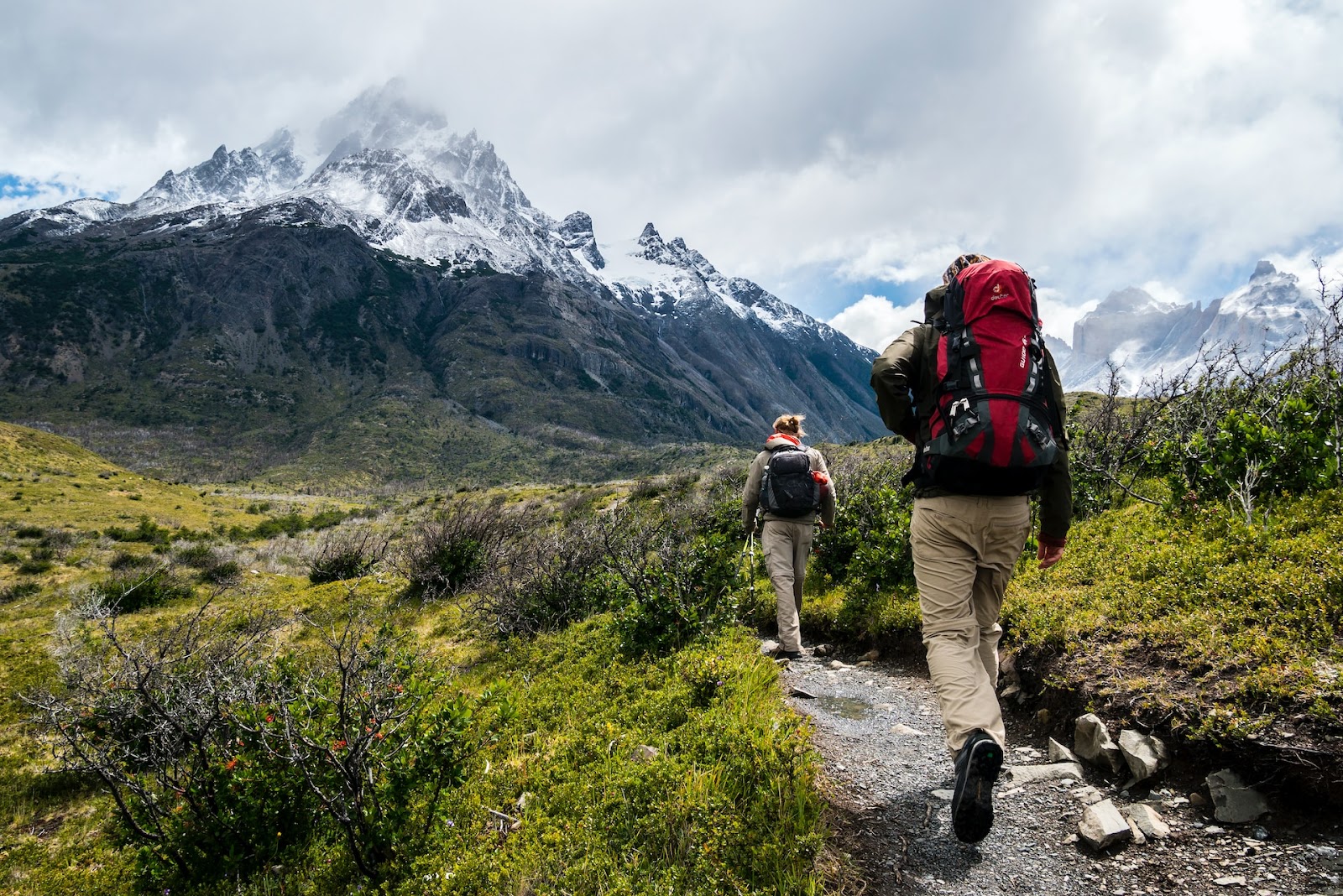Hiking is a fantastic way to explore nature and stay fit. However, it requires a certain level of physical fitness to enjoy the experience fully. Here are some tips for getting in shape for hiking:
| Tip | Explanation |
| 1. | Start with short hikes and gradually build up to longer ones. This allows your body to adjust to the physical demands of hiking. |
| 2. | Incorporate cardiovascular exercises like walking, running, or cycling into your fitness routine. These exercises can help improve endurance and stamina. |
| 3. | Practice strength training exercises that target the legs, core, and upper body. This helps build the muscles needed for hiking. |
| 4. | Remember to stretch before and after your workouts. Stretching can help prevent injuries and improve flexibility. |
| 5. | Invest in good-quality hiking gear such as shoes, a backpack, and trekking poles. This will support your body and make hiking easier. |
By following these tips, you’ll be well on your way to getting in shape for hiking and enjoying all that nature offers.
Cardiovascular Endurance Training
Cardiovascular endurance training should be a priority when getting in shape for hiking. Cardio endurance will help you gain muscle strength, improve aerobic capacity, and prepare your body for the demands of a long hike.
This section will discuss the different types of cardiovascular endurance training and how to put together an appropriate exercise program.
Importance of Cardiovascular Endurance For Hiking
Cardiovascular endurance is crucial for hiking, which involves prolonged periods of physical activity over varied terrain. Here are some tips for getting in shape for hiking through cardiovascular endurance training:
| Start with low-intensity exercises like brisk walking, cycling, or swimming. |
| Gradually increase the intensity and duration of your workouts. |
| Incorporate aerobic exercises that target your legs and core like jogging, stair climbing, or uphill running. |
| Include strength training exercises that improve your lower body strength, such as lunges, squats, and calf raises. |
| Practice hiking on similar terrain to your target trail to acclimate your muscles to the physical demands of hiking and improve your agility and balance. |
| Remember to stay hydrated and take breaks as needed during your workout. |
With consistent cardiovascular endurance training, you can be sure to tackle even the toughest hiking trails.
Interval Training to Improve Endurance
Interval training is a highly effective method for improving cardiovascular endurance that can help you get in shape for hiking. By alternating high-intensity exercise with periods of rest or lower-intensity exercise, you can improve your heart health, increase your lung capacity, and build your stamina for long hikes.
Here are some tips for interval training to improve endurance:
| Tip | Description |
| Start small | Begin with shorter intervals and build up gradually as you become more fit. |
| Mix it up | Vary the types of exercises you do during your intervals to keep things interesting and challenge your body in different ways. |
| Focus on form | Poor form can lead to injury and decrease your workouts’ effectiveness. Make sure you’re using the proper form for each exercise you do. |
| Rest and recover | Make sure to give your body time to rest and recover between interval training sessions to avoid injury and burnout. |
By incorporating interval training into your exercise routine, you can improve your endurance and get in shape for hiking even faster. Plus, it’s a fun and challenging way to mix up your workouts and keep things interesting!
Incorporating Cardio Into Daily Routine
Incorporating cardio into your daily routine is crucial for building cardiovascular endurance and getting in shape for hiking. Here are some tips to help you get started:
| Start Slow: | Begin with low-intensity cardio exercises like walking, cycling, or swimming for 30 minutes daily, gradually increasing the intensity and duration. |
| Mix it up: | Vary the cardio exercises you do to keep things interesting and challenge your body. |
| Set Goals: | Set realistic goals for yourself and track your progress to stay motivated. |
| Find a Workout Buddy: | Working out with a friend or family member can help you stay accountable and make the process more enjoyable. |
| Make it a Habit: | Incorporate cardio into your daily routine by scheduling workout sessions into your calendar and sticking to them. |
| Pro Tip: | Remember to warm-up and cool down before and after each cardio session to prevent injuries and maximize the benefits. |

Strength Training
Strength training is an essential part of getting into shape for hiking. It will not only help you to develop the necessary muscles and strength needed to hike, but it can also help to reduce injuries and prevent fatigue.
In this section, we will look at the exercises you can do to build up the strength needed for tackling long hikes.
Importance of Strength Training For Hiking
Strength training is an essential aspect of getting in shape for hiking, as it helps prepare your body for the physical demands of the trail. Here are some tips for incorporating strength training into your hiking fitness routine.
Start with bodyweight exercises: Exercises like squats, lunges, and push-ups are effective ways to strengthen your legs, core, and upper body.
Incorporate resistance training: Resistance bands, dumbbells, and kettlebells can add an extra challenge to your strength training routine and help build endurance.
Focus on functional movements: Exercises that mimic the actions you’ll make while hiking like step-ups and calf raises, can be especially beneficial.
Stay consistent: Aim to strength train at least 2-3 times weekly, gradually increasing the weight and resistance.
Pay attention to cardio: Strength training is important, but it’s also essential to incorporate cardiovascular exercise into your routine to build stamina and endurance.
By incorporating these tips into your strength training routine, you’ll be well on your way to getting in shape for your next hiking adventure!
Exercises to Target Hiking-Specific Muscles
Strength training exercises can help you get in shape for hiking by targeting specific muscles used in hiking. Here are some exercises that can help:
| Exercise | Benefits |
| Squats | This exercise strengthens your quadriceps, hamstrings, and glutes, which are important muscles for uphill hiking. |
| Lunges | Lunges work your leg muscles, particularly your quadriceps and hamstrings, and improve your balance and stability. |
| Calf raises | Strong calves are essential for powering uphill climbs, and calf raises build strength in this muscle group. |
| Step-ups | This exercise works your quads, hamstrings, and glutes while also improving your balance and coordination. |
| Planks | Planks strengthen your core, essential for maintaining balance and stability on uneven terrain. |
Incorporating these exercises into your fitness routine will improve your strength, balance, and endurance, making your next hiking adventure easier and more enjoyable.
Power Hiking Drills
Power hiking drills are essential for building strength and endurance to prepare for hiking. These drills mimic the movement patterns and intensity of hiking, helping you to develop the specific skills needed to tackle hilly or mountainous terrain.
Here are a few tips for getting in shape for hiking:
| Power uphills | Lunges | Side Stepping | One-Legged Balance Poses |
| Use a hill or incline to simulate uphill hiking. Walk up the hill with full force, pump your arms, and take long strides. Gradually increase the incline and speed to improve your strength and endurance. | Lunges help activate and strengthen your glutes, quads, and hamstrings, key muscle groups used in hiking. Traversing a trail requires lifting your legs and climbing uphill, making lunges an excellent exercise choice. | As you hike, you may encounter rough terrain that can be challenging to navigate. Side steps help you to improve your stability and balance by strengthening your core muscles, hips, and glutes. | Balance is essential when hiking, especially when navigating difficult terrain. Practicing one-legged balance poses helps to improve your proprioception, which is your ability to sense your body’s position in space. |
Pro Tip: Hiking can be strenuous, especially if you’ve never tried it before. Start slowly, and gradually increase the intensity and duration of your hikes as you build strength and endurance.
Flexibility And Stretching
Flexibility and stretching are important components of any fitness program and are especially important when getting in shape for hiking. Stretching loses up the muscles and helps to prevent injuries while increasing the range of motion. It can also help to reduce pain and recover faster after a strenuous hike.
In this article, we’ll explain how to create an effective stretching routine to get in shape for hiking.
Importance of Flexibility For Hiking
Flexibility is essential for hikers, and stretching is crucial for getting in shape for hiking. Stretching before and after a hike can improve your range of motion, decrease your risk of injury, and aid in muscle recovery.
Here are some tips to keep in mind:
| Start with dynamic stretching exercises that warm up your muscles and increase blood flow. |
| Hold static stretches for at least 30 seconds to improve your flexibility. |
| Focus on stretching your legs, hips, back, and shoulders, commonly used during a hike. |
| Incorporate yoga or Pilates into your fitness routine to increase your overall flexibility. |
| Remember to stretch after a hike to reduce muscle tension and soreness. |
Incorporating stretching into your hiking routine can improve your performance, prevent injuries, and have a more enjoyable hiking experience.
Stretches For Hiking-Specific Muscles
Stretches can help in getting in shape for hiking by improving flexibility, increasing range of motion, and decreasing the risk of injury. Here are some stretches that target the muscles most commonly used in hiking:
| Quadriceps stretch: | Stand facing a wall, tree or any stable support. Grab its top with one of your hands and bring the right leg behind you. Place the top of your right foot against the wall and lower your hips until you feel a stretch in your right quadriceps. Hold for 30 seconds, then repeat with the other leg. |
| Hamstring stretch: | Sit straight with one leg in front of you and the other bent at the knee with the sole of your foot touching your thigh. Keep your back straight and lean forwards towards the extended leg, feeling the stretch in your hamstring. Hold for 30 seconds, then repeat with the other leg. |
| Calf stretch: | Stand facing a wall, tree or any stable support. Put your hands on the wall, then place one leg behind you with the heel on the ground. Keep the back leg straight, and lean forward until you feel a stretch in the calf. Hold for 30 seconds, then repeat with the other leg. |
| Hip flexor stretch: | Kneel on one knee, and place the other foot in front of you with the knee bent at a ninety-degree angle. Lean forward towards the front leg, feeling the stretch in the hip flexor of the back leg. Hold for 30 seconds, then repeat with the other leg. |
Pro tip: Remember to stretch after hiking to reduce muscle soreness and increase overall flexibility.
Yoga And Pilates For Hikers
Yoga and Pilates are excellent ways to increase flexibility and strength, preparing your body for the demands of hiking. Here are some tips to get in shape for hiking:
| 1. Use yoga and Pilates to build strength and flexibility in your legs, core, and back muscles. These exercises will help you maintain balance, avoid injury, and increase endurance. |
| 2. Focus on poses that improve balance, such as the Warrior III pose in yoga or the single-leg bridge in Pilates, which can simulate uneven terrain and strengthen stabilizing muscles. |
| 3. Add stretching exercises to your routine to increase circulation, prevent stiffness, and promote relaxation. Incorporating foam rolling and using lacrosse balls to target specific areas of tightness can also help reduce muscle soreness. |
| 4. Practice breathing techniques to help calm your mind, lower your heart rate, and increase your oxygen intake while hiking. |
Pro tip: Start slow and build up your endurance gradually. Listen to your body and take breaks to avoid overexertion or injury.

Nutrition And Recovery
When preparing for a hike, nutrition and recovery are key in helping you stay in shape. Eating correctly and recovering adequately can help you maximize the gains of your hiking trips and ensure you stay energized and healthy.
In this section, we’ll discuss some tips on ensuring your nutrition and recovery are up to par for your upcoming hikes.
Importance of Proper Nutrition For Hikers
Proper nutrition is essential for hikers, especially when preparing for a long and challenging hike. Here are some useful tips for enhancing your nutrition and recovery regime and getting in good shape for hiking.
| Tip | Action |
| Stay hydrated | Drinking enough water helps regulate body temperature and prevent dehydration. |
| Eat balanced meals | Include a variety of nutrient-rich superfoods, such as whole grains, fruits, vegetables, nuts, and lean protein sources, in your daily meals. |
| Load up on electrolytes. | Hiking for long periods can cause a loss of electrolytes. Drink coconut water, and eat bananas and yogurts, to keep your electrolytes level in check. |
| Carb loading | Consume carbohydrate-rich foods a few days before a long hike to store energy in your muscles to tackle the walk better. |
| Proper recovery | After hiking, consume healthy foods, and focus on rebuilding glycogen stores with protein and carbs. |
By adhering to these nutrition and recovery tips, you’ll reduce the risk of exhaustion and injury while enhancing your overall performance during a hike.
Pre And Post-Hiking Nutrition Tips
Getting in shape for hiking requires more than just physical preparation. Nutrition before, during, and after your hike also plays a crucial role in your performance and recovery. Here are some pre and post-hiking nutrition tips:
| Pre-hike: |
| 1. Carbohydrates are a reliable energy source, so consume a fulfilling meal rich in carbs 2-3 hours before the hike. |
| 2. Hydrate yourself sufficiently to avoid muscle cramps and dehydration. |
| During the hike: |
| 1. Consume carbohydrates in the form of energy bars, granola, or fruits to maintain energy levels. |
| 2. Stay hydrated and consume electrolyte-rich drinks for better bodily fluid balance. |
| Post-hike: |
| 1. Replenish your body with carbohydrates, protein, and healthy fats to aid muscle recovery within an hour of finishing the hike. |
| 2. Continue to hydrate yourself and replace any electrolytes lost to the body during the hike. |
By following these tips, you can maintain your energy levels and recover faster after hiking. Pro tip: Consult a professional nutritionist to determine the number of nutrients you require per hike, as every person’s dietary needs differ.
Recovery Techniques For Hikers
Hiking is a physically demanding activity that requires proper nutrition and recovery techniques to get in shape and stay in shape. Here are some tips to consider:
| Nutrition: | Focus on eating a balanced diet that includes carbohydrates, proteins, and healthy fats. Add whole grains, lean meats, and fruits and vegetables to your meals. Stay hydrated by drinking water and electrolyte-rich beverages such as sports drinks. |
| Recovery: | After a hike, stretch your muscles and cool down by walking for a few minutes. Treat sore muscles and joints with ice or heat therapy as needed. Take rest days to allow your body to recover and avoid overuse injuries. Incorporate low-impact exercises such as yoga or swimming into your routine to build strength and endurance without adding stress to your joints. |
Pro tip: Consult with a healthcare professional before starting any new physical activity or changing your diet.

Preparing For Altitude And Terrain
Getting in shape for hiking can be challenging, especially when the altitude and terrain are harder than you are used to. Preparing ahead can help you be more successful and enjoy your adventure even more.
Here are some tips for getting in shape for hiking that can help you get ready for the higher altitude and tougher terrain:
| Tip | Explanation |
| 1. Train with a backpack | Adding weight to your workout can help you be stronger on the trail. |
| 2. Increase your cardio | Increasing your cardio can help you be more successful on longer hikes. |
| 3. Increase your flexibility | Being flexible can help you be more agile on different types of terrain. |
Importance of Altitude Training For Hikers
Altitude training is crucial for hikers to prepare for high-altitude terrain, reduce the risk of altitude sickness and improve their overall performance.
Here are the top tips for getting in shape for hiking:
| Start training at least 6-8 weeks before your hike. |
| Focus on cardiovascular exercises such as hiking, running, or cycling to improve endurance and lung capacity. |
| Incorporate strength training exercises such as squats, lunges, and planks to build muscle and improve balance. |
| Gradually increase the intensity and duration of your workouts to mimic the conditions you will face on your hike. |
| Practice hiking with a loaded backpack to prepare for the weight you will carry on your trip. |
| Stay hydrated and fuel your body with nutritious meals to improve performance and reduce the risk of altitude sickness. |
Following these tips and training regularly, hikers can ensure a safe and enjoyable trip to high-altitude terrain.
Terrain-Specific Training
Preparing for high altitudes and varied terrain is crucial when getting in shape for hiking. Here are some tips to help you get ready for your next trek:
| Tip | Description |
| Gradually increase your cardiovascular activity | including walking, cycling, and swimming. |
| Incorporate hill or stair climbing | into your routine to improve cardiovascular endurance and build leg muscles. |
| Wear the same shoes and backpack | you plan hiking with during training to simulate real-life conditions. |
| Practice hiking on hills and uneven terrain | to build balance and leg strength. |
| Gradually increase the altitude of your training hikes | starting at your local elevation and working your way up to your desired trek height. |
| Incorporate breathing exercises and proper hydration techniques | to acclimate to high altitude conditions. |
Pro tip: If possible, plan to arrive at your hiking destination a few days early to acclimate to the altitude before beginning your trek.
Preparing For Hiking at High Altitudes.
Preparing for a high-altitude hike requires more than just packing the right gear. Getting in shape and acclimating your body to the challenges of hiking at altitude is essential. Here are a few tips for getting in shape for hiking:
| Start early: | Begin your training regimen at least a month before your hike. This will give your body enough time to adjust to the new exercise routine. |
| Walk or run uphill: | Walking or running uphill is the best way to simulate the exertion of hiking at a high altitude. This will help build your stamina and endurance. |
| Lunges and squats: | These exercises help to strengthen your leg muscles, which are essential for hiking. |
| Cardio: | It’s essential to have strong cardiovascular health for high-altitude hiking. Engage in activities like swimming or cycling to increase your heart rate and improve your lung capacity. |
| Stretching: | Incorporate stretches into your routine to improve your flexibility and prevent injury. |
Pro tip: Don’t forget to stay hydrated and take breaks on your hike to allow your body to acclimate to the altitude.
